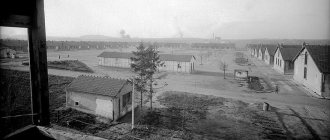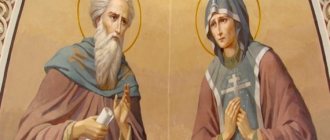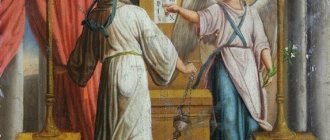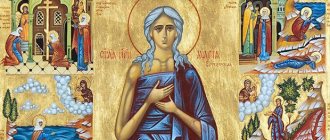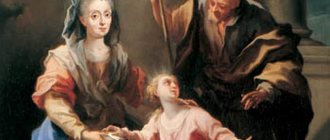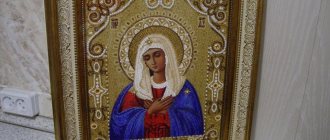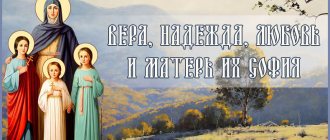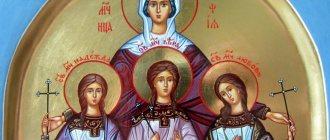influence
In February 1908, she met A. Blok. Attended meetings “at the tower” of Vyach. Ivanova, meetings of the “Workshop of Poets”, religious and philosophical meetings, communicated with Nikolai Gumilyov, Anna Akhmatova, Osip Mandelstam, Mikhail Lozinsky.
Spiritual daughter Fr. Sergius Bulgakov. In exile she was close to the circle of Nikolai Berdyaev and Georgy Fedotov.
- Nikolai Berdyaev and mother Maria (1930).
- Seminar about. Sergius Bulgakov on asceticism and culture (1933).
- Metropolitan Evlogy (Georgievsky), John Mott and mother Maria (Skobtsova).
- Congress of the RSHD, 1937.
- Congress of the "Orthodox Cause". France, Boissy-l'Ayerie, 1937.
- Mother Maria (Skobtsova), Dorothy Day, Fr. Leo (Gillet), Mother Teresa, Fr. Alexander Shmeman. "New Skete" (Cambridge, New York).
The modernist bestseller by Fr. is dedicated to Mother Mary. Sergius Gakkel “One of Great Price. The life of Mother Marie Skobtsova, Martyr of Ravensbruk" ("Mother Mary") (1965).
In Alexei Tolstoy’s novel “Walking Through Torment,” the St. Petersburg period of her life served as the prototype for the character “Elizaveta Kievna.” The 1982 film “Mother Maria” with Lyudmila Kasatkina in the title role is dedicated to the fate of Mother Maria.
In France there is the “Society of Mother Mary”, in St. Petersburg - the “Union of Friends of Mother Mary”, in Riga - the “Society of Friends of Mother Mary” (co-chairman Elena Pavlova[1]). In 1999, the Orthodox Cause society named after. mother Maria (chairman A. A. Solovyov). There is an exhibition about her in the folk museum of the village. Yurovka, where the estate of the Pilenko family was. A memorial hall dedicated to her has been created in the Anapa Archaeological Museum. A memorial sign has been installed on the Anapa embankment. The name of Mother Maria is immortalized on memorial plaques in Paris and Riga, St. Petersburg and Ravensbrück. In Jerusalem, at the Yad Vashem Museum on the Alley of the Righteous Among the Nations, an olive tree was planted in her honor, and a memorial plaque was installed in the Alexander Metochion[2].
On March 31, 2016, the opening ceremony of the street named after Maria (Skobtsova) took place in Paris. The new street adjoins Rue Lourmel in the XV arrondissement, where the Orthodox Cause association was located[3].
Ksenia Krivosheina, who has written several books and many articles about her, is popularizing the works and legacy of Maria (Skobtsova). She also created the website www.mere-marie.com.
estimates
What representatives of the Parisian school of theology were often reproached for: Bulgakov, Berdyaev, Zenkovsky, Mother Maria (Skobtsova) - “cigarette theology.” They could talk about God while smoking a cigarette. This is certainly an indicator of sensitivity, but what they say when smoking a cigarette is important. If they say something good, let's listen.
When Metropolitan Anthony first saw Mother Maria, he was shocked because he saw her, a Russian nun, in a Parisian cafe, drinking beer with someone. It seemed to him that this was impossible! But Metropolitan Anthony came to understand that she served God well[4].
- ep. Seraphim (Sigrist)
Mother Mary is truly an unusual saint. She smoked and led a bohemian lifestyle before her tonsure, and even after her tonsure she did not look like a quiet nun, busy only with prayer and fasting. Her monasticism was not a death to the world, but something quite the opposite—that shocking invasion into the world that clearly testified to the vitality of Christianity. She was able to accomplish a lot in her life, for which she is truly worthy of church veneration. Her life creativity surpasses poetic creativity, and there is novelty in this too[5].
- O. Georgy Mitrofanov
Death of father, move and first marriage
After the death of her father, Sofia Borisovna and her children finally moved to St. Petersburg. Lisa enters the L.S. Tagantseva gymnasium.
In St. Petersburg she finds herself among the creative young intelligentsia.
Meet the elite of world poetry. At the age of 15 she met Blok. This meeting became significant for Lisa over the years and blossomed into a complex and deep friendship.
Elizaveta Yurievna Pilenko. Creative meetings and evenings, getting to know Blok. Mental confrontation and the release of the first collections
Lisa had many friends, poets, writers, and publicists. In 1910, she married assistant attorney at law Dmitry Kuzmin-Karavaev. She and her husband visit a lot of literary circles.
But the more she invades this world of art and bohemianism, the more she does not find her spiritual place in it. She is looking for herself, trying to understand herself.
Scythian shards
the first collection of poems by Elizaveta Pilenko
Despite such emotional confrontation, she releases her first collection of poems, “Scythian shards.”
Then her books “Ruth” and “Yurali” were published. In these works, young Lisa tried to find the first paths of religious Christian thought.
canonization
On November 13, 1991, in a speech before the rabbis, Patriarch Alexy mentioned Mother Maria (Skobtsova):
During World War II and the Nazi occupation, the clergy and believers of our Church risked their lives to shelter Jews. Classic examples of this are Mother Maria (Skobtsova), priests Dmitry Klepinin and Alexei Glagolev, and many others, about whose exploits, about their sacrificial service to the salvation of their Jewish brothers and sisters, we should all know[6].
In August 1993, at an ecumenical congress in Pomerol, organized by the Protestant women's community, a petition was drawn up and sent to Patriarch Alexy II of Moscow for the glorification of Mary (Skobtsova) and her companions, signed by Orthodox, Protestant and Catholic theologians[7].
In 2000, Met. Anthony (Bloom) turned to Metropolitan. Juvenaly Krutitsky and Kolomensky, as the Chairman of the canonization commission, to consider the issue of glorifying Mother Mary[8].
On January 16, 2004, she was canonized by the Patriarchate of Constantinople as a venerable martyr[9].
During the solemn rite of glorification of the newly canonized saints on May 1-2, 2004, in the Alexander Nevsky Cathedral in Paris, Christians of different denominations participated in the services. The Archbishop of Paris, Cardinal Jean-Marie Lustige, said Catholics would also honor these martyrs as saints and patrons of France.
In 1940, Mother Maria's house became a refuge for partisans and Jews.
In 1940, the Germans came to Paris and the occupation began.
But difficult times did not allow Mother Maria to droop and withdraw into herself. She blessed the Lord and helped people.
1940
this year Paris was occupied by the Germans, but Maria continued to help those in need
She established contact with the mayor's office, her house was taken under patronage and declared a municipal canteen.
This allowed Mother Mary to feed children, women, and cripples. The mayor's office allocated cards and food for this canteen.
Mother Maria's house quickly became famous; partisans, Jews, and anyone else in danger found refuge there.
Mother Maria was closely associated with the Resistance movement.
She obtained false documents for partisans, organized the forwarding of letters and parcels for prisoners, and saved three Jewish children by hiding them in trash cans.
biography
On February 19, 1910, Elizaveta Pilenko married assistant attorney Dmitry Kuzmin-Karavaev, a former Bolshevik and close friend of many St. Petersburg writers. In the spring of 1913, she left her husband (the divorce was officially filed only at the end of 1916) and left St. Petersburg for Anapa.
In the summer of 1919, Kuzmina-Karavaeva married D. E. Skobtsov, a Kuban Cossack leader who was for some time the chairman of the Kuban Regional Rada. In the spring of 1920, after the defeat of the White movement in Kuban, Elizaveta Skobtsova with her mother S. B. Pilenko and daughter Gayana were evacuated to Georgia, where Elizaveta Yuryevna had a son, Yuri, then the entire Skobtsov family emigrated to Constantinople, lived for some time in Serbia, and in January 1924 she moved to Paris.
During the Nazi occupation of Paris, the hostel of the nun Maria on the Rue de Lourmel became one of the headquarters of the Resistance. In June 1942, when the Nazis carried out mass arrests of Jews in Paris and herded them to the winter velodrome for subsequent transport to Auschwitz, nun Maria managed to secretly remove four Jewish children from there in garbage containers. Houses on Lourmel and Noisy-le-Grand became shelters for Jews and prisoners of war, M. Maria and Fr. Dimitry Klepinin also issued fictitious baptismal certificates to Jews.
On February 9, 1943, the Gestapo arrested Maria (Skobtsova), who was first kept in the prison of Fort Romainville and then sent to the Ravensbrück concentration camp. Nun Maria was executed in the Ravensbrück gas chamber on March 31, 1945, a week before the liberation of the camp by the Red Army.
On May 7, 1985, by decree of the Presidium of the Supreme Soviet of the USSR, she was awarded the Order of the Patriotic War, II degree (posthumously)[10].
Maria Skobtsova spent her childhood in Anapa and Crimea
Lisa Pilenko was born in 1891 in Prague. Her father, Yuri Dmitrievich Pilenko, was a lawyer, and her mother, Sofia Borisovna, came from the famous Dmitriev-Mamonov family.
When Lisa was 4 years old, the family moved to Anapa. After the death of Lisa's grandfather, her father inherited the estate and vineyards.
December 20, 1891
Maria Skobtseva's birthday
With the help of her parents and the intelligentsia of Anapa, young Lisa received her primary education at home. From early childhood, she showed great talent for drawing and literature.
Her father devoted a lot of time to raising and teaching children. She loved her father very much, he was her first friend.
In the house of the Pilenko family there was always an atmosphere of friendliness, openness, and goodwill. This greatly influenced the future fate of little Lisa, and left a deep mark on her upbringing and spiritual growth.
Liza Pilenko, 1903. I spent my childhood in the south, in Anapa and Crimea. She grew up in an atmosphere of love and mutual respect. This greatly affected her mental and spiritual growth.
In the spring of 1905, her father was appointed director of the Nikitsky Botanical Garden.
The family moves to Crimea. And then, in 1906, Lisa’s father was transferred to St. Petersburg to the Department of Agriculture.
He brings his wife and children to St. Petersburg, and he himself returns to Anapa and suddenly dies.
1906
this year Maria’s family is moving to St. Petersburg
The death of her father greatly shocked Lisa and became a real blow of fate.
Even then, a protest against death and injustice arose in her soul. More and more often she began to think about God.
ideology
Kuzmina-Karavaeva greeted the February Revolution with enthusiasm and already in March 1917 joined the Socialist Revolutionary Party. She spent most of 1917 in Anapa, and in February 1918 she was elected mayor. When, after a short period of dual power, the Bolsheviks completely took power in the city, Kuzmina-Karavaeva took the post of Commissioner for Health and Public Education. In May 1918, she participated in the congress of the Right Socialist Revolutionary Party in Moscow and carried out underground anti-Bolshevik work; in the fall she returned to Anapa, where she was arrested by Denikin’s counterintelligence - she faced the death penalty for “commissarism” and participation in the nationalization of private property. On March 15, 1919, her case was considered by the regional military district court in Yekaterinodar, and only thanks to a skillfully organized defense, the defendant received only two weeks of arrest.
In 1913 - divorce, birth of a daughter
Lisa leaves all literary collections and continues her journey in search of faith. She attends theological courses at the Theological Academy. Successfully passes the exam. She was the first woman to be blessed with this teaching.
In 1913, Elizaveta Yuryevna left her husband and returned to her family estate in Anapa.
In the same year, her daughter Gayana is born. During these years, Elizabeth embarked on a path of mental discord and crossroads. She thinks more and more about God, the meaning of life.
organizations
Secretary of the Religious and Philosophical Academy (1920s), made reports at its meetings.
Since 1927, she became an active figure in the Russian Student Christian Movement (RSCM), as a traveling secretary, she traveled around France, visiting Russian emigrant communities, and gave lectures and reports. Participant in the RSHD congress in Estonia (1933).
In 1932, with the blessing of her spiritual father, Archpriest Sergius Bulgakova, she began her pseudo-monastic service in the world.
She organized a hostel for single women in Paris, a rest home for convalescent tuberculosis patients in Noisy-le-Grand near Paris, painted house churches, embroidered icons and shrouds for them. At the hostel, the Church of the Intercession of the Blessed Virgin Mary and courses for psalm-readers were established, and from the winter of 1936-1937 - missionary courses. On September 27, 1935, on the initiative of nun Maria, the charitable and cultural-educational society “Orthodox Cause” was created, which included Nikolai Berdyaev, Sergei Bulgakov, Georgy Fedotov, Konstantin Mochulsky.
She was a member of the literary association “Circle” (1935-1939).
The Germans arrested her son Yuri and mother Maria. She was executed in the Ravensbrück concentration camp
In 1943, the Germans arrested Maria's son, Yuri. Maria's mother, who was not in Paris at that time, was told that her son would be released if she herself presented herself to the Gestapo.
When she got there, she was immediately arrested without releasing anyone. Her son died in 1944 in the Dora concentration camp. Mother Maria was executed in a gas chamber in the Ravensbrück concentration camp.
Nun Maria, born Elizaveta Yurievna Pilenko. Mother Mary suffered many bitter losses
pathological speech
Churchness
I think that you shouldn’t go further than the 19th century in search of the modern meaning of this word, because it is not of ancient origin. It is most likely that its ancestors were Slavophiles and, mainly, late Slavophiles. Most often it began to be used in connection with the slogan of the ecclesiasticalization of life. It was supposed, as it were, that the ecclesiasticalization of life has as its fruit ecclesiastical
the one who has taken this path.
But rarely does anyone who speaks about the ecclesiasticalization of life give an exact definition of this concept, especially the concept of churchliness
[11].
Mother of God - mother of cheese earth
- The world is protected by the protection of the Mother of God, and she is the mother of the damp earth[12].
essays
- Kuzmina-Karavaeva, E.
Scythian shards. - St. Petersburg: Workshop of Poets, 1912. - Kuzmina-Karavaeva, E. (Mother Mary)
Harvest of the spirit / Compilation, preparation of texts, notes - A. N. Shustov. - St. Petersburg: Art-SPB, 2004. - ISBN 5-210-01543-2. - Kuzmina-Karavaeva E. Yu.
How I was a mayor // Will of Russia. - 1925. - No. 4. - P.63 - 80; No. 5. - pp. 68-88. - Maria (Skobtsova), mother.
“Here is a bare bush, but here is a hungry beast...” // Journal of the Moscow Patriarchate. - 1988. - No. 3. - P. 77. - Maria (Skobtsova), mother.
Types of religious life // Bulletin of the Russian Christian Democracy. - 1998. - No. 178. - Kuzmina-Karavaeva E. Yu.
Russian Plain / Compilation, introductory article, notes - Shustov A. N. - St. Petersburg: Art - St. Petersburg, 2001. - ISBN 5-210-01541-6. - Maria (Skobtsova), mother.
The present and future of the church. What is churchliness? - K.: Quo vadis, 2010. - P. 252. - Mother Maria (Skobtsova; Kuzminina-Karavaeva E. Yu.) // Saving beauty: painting, graphics, embroidery / Compiled and author Ksenia Krivosheina, foreword by Metropolitan Kirill of Smolensk. afterword by prof. Georges Nives (France); notes, chronicle of the life of mother Maria - Shustov A. N. - St. Petersburg: Art-SPB, 2004. - ISBN 5-210-01573-4.
- See also bibliography up to 2000 - Date of access: 09/25/2017.
Maria SkobtsovaSkobtsova Elizaveta Yurievna
Russian poetess. Publicist. Public figure. Member of the French Resistance. Nun of the Western European Exarchate of the Russian tradition of the Patriarchate of Constantinople. Canonized by the Patriarchate of Constantinople as a venerable martyr in January 2004.
Elizaveta Pilenko was born on December 20, 1891 in Riga, Latvia. The girl was born into the family of lawyer Yuri Dmitrievich and Sofia Borisovna. In 1895, his father retired and moved with his family to Anapa, where the Dzhemete estate with vineyards was located nearby, which he inherited after the death of his father, a retired general and winemaker. In May 1905, for his success in viticulture, Pilenko was appointed director of the Imperial Nikitsky Botanical Garden and the School of Horticulture and Winemaking.
Soon, the family moved to Yalta, where Lisa graduated from the fourth grade of the Yalta girls' gymnasium with a 2nd degree award. In the spring of 1906, my father was transferred to serve in St. Petersburg, but did not have time to leave for his destination, since on July 17 of the same year he died suddenly in Anapa. The daughter was shocked by this tragedy and, in her own words, lost faith in God.
In August 1906, the widowed Sofia Borisovna and her children moved to St. Petersburg. Elizabeth studied for two years at the private gymnasium of Lyubov Tagantseva, and then moved to the gymnasium of Maria Stoyunina, from which she graduated in the spring of 1909 with a silver medal and entered the higher Bestuzhev courses, the philosophical department of the Faculty of History and Philology. In February 1908, she met Alexander Blok, with whom she subsequently began a complex relationship and long correspondence.
On February 19, 1910, Elizaveta Pilenko married assistant attorney Dmitry Kuzmin-Karavaev, a former Bolshevik and close friend of many metropolitan writers. Together with him she attended meetings “on the tower”, meetings of the “Workshop of Poets”, religious and philosophical meetings, talked with Nikolai Gumilyov, Anna Akhmatova, Osip Mandelstam, Mikhail Lozinsky.
During this period, Elizaveta left the Bestuzhev courses without receiving a diploma. In the spring of 1912, she published her first collection of poems, “Scythian shards,” which was positively received by critics. Soon Kuzmina-Karavaeva began to feel burdened by the atmosphere of the capital’s aesthetic elite and went first to the German resort of Bad Nauheim, and then to the Crimea, where she communicated with Alexei Tolstoy, Maximilian Voloshin, Aristarkh Lentulov.
In the spring of 1913, she left her husband and went to Anapa. The divorce was officially finalized only three years later. At the beginning of 1914, she sent Blok the manuscript of her new book of poems, “The Road,” which she returned with comments in the margins, but the collection was never published.
For Kuzmina-Karavaeva, the time has come for mental discord, a “crossroads.” She became increasingly interested in religious issues and reflected on the purpose and meaning of life. In April 1915 she published the philosophical story “Yurali”, stylized as a Gospel, and in April 1916: a collection of poems “Ruth”, which included many poems from the unpublished “Road”.
Kuzmina-Karavaeva greeted the February Revolution with enthusiasm and already in March 1917 joined the Socialist Revolutionary Party. She spent most of 1917 in Anapa. In February 1918, she was elected mayor. When, after a short period of dual power, the Bolsheviks completely took power in the city, Kuzmina-Karavaeva, although she did not share the Bolshevik ideology, took the post of Commissioner for Health and Public Education.
In May 1918, she participated in the congress of the Right Socialist Revolutionary Party in Moscow and conducted underground anti-Bolshevik work. In the fall of the same year she returned to Anapa, where she was arrested by Denikin’s counterintelligence. She faced the death penalty for “commissarism” and participation in the nationalization of private property. On March 15, 1919, her case was considered by the regional military district court in Krasnodar, and only thanks to a skillfully organized defense, the defendant received only two weeks of arrest.
In the summer of 1919, Kuzmina-Karavaeva married Daniil Skobtsov, a Kuban Cossack leader and former chairman of the Kuban Regional Rada. In the spring of 1920, after the defeat of the White movement in Kuban, Elizaveta and her daughter Gayana were evacuated to Georgia, where her son Yuri was born. Then the entire Skobtsov family emigrated to Istanbul. She also lived for some time in Serbia, where her daughter Anastasia was born on December 4, 1922, and in January 1924 she moved to Paris.
Before 1925, Elizaveta Skobtsova published in emigrant magazines the stories “Russian Plain” and “Klim Semenovich Barynkin”, which described the tragedy of the Civil War, autobiographical essays “How I Was a City Mayor” and “Friend of My Childhood”, as well as a memoir-philosophical essay “The Last Romans."
A huge grief for Skobtsova was the death of her youngest daughter on March 7, 1926 from meningitis. Shocked by grief, Elizabeth felt spiritual rebirth and discovered a new meaning in life in serving people in the name of God. Since 1927, she became an active figure in the Russian Student Christian Movement. As a traveling secretary, she traveled around France, visiting Russian emigrant communities, gave lectures, reports, and published notes about the difficult life of emigrants. She graduated in absentia from the St. Sergius Orthodox Theological Institute in Paris.
In the church of the St. Sergius Orthodox Theological Institute on March 16, 1932, she received monastic vows from Metropolitan Evlogii, receiving the name Maria in honor of St. Mary of Egypt, and with the blessing of her spiritual father, Archpriest Sergius Bulgakov, she began her unconventional monastic service in the world, devoting herself to charitable and preaching activities .
In Paris, Maria Skobtsova organized a hostel for single women and a rest home for recovering tuberculosis patients. Moreover, she did most of the work there herself: she went to the market, cleaned, cooked food, painted house churches, embroidered icons and shrouds for them. At the hostel there was a Church of the Intercession of the Blessed Virgin Mary and courses for psalm-readers, where missionary courses soon appeared.
On the initiative of nun Maria, on September 27, 1935, the charitable and cultural-educational society “Orthodox Cause” was created, which included Nikolai Berdyaev, Sergei Bulgakov, Georgy Fedotov, Konstantin Mochulsky.
Nun Maria gave presentations, published theological and acute social articles, and on the fifteenth anniversary of the death of Alexander Blok, she published a memoir essay “Meetings with Blok” in the journal “Modern Notes.” Despite being incredibly busy, she devoted a lot of time to poetry. In 1937, her collection “Poems” was published in Berlin; in the late 1930s and early 1940s she wrote the poetic mystery plays “Anna”, “Seven Cups” and “Soldiers”.
During the occupation of Paris, the hostel of the nun Maria on the Rue de Lourmel became one of the headquarters of the Resistance. In June 1942, when the Nazis carried out mass arrests of Jews in Paris and herded them to the winter velodrome for subsequent transport to Auschwitz, nun Maria managed to secretly remove four Jewish children from there in garbage containers. Houses on Lourmel and Noisy-le-Grand became shelters for Jews and prisoners of war, Maria and Dimitri Klepinin also issued fictitious baptismal certificates to Jews, which sometimes helped.
On February 8, 1943, the Gestapo arrested her son Yuri, and on February 9, Maria herself, who was first kept in the prison of Fort Romainville and then sent to the Ravensbrück concentration camp. Son, Yuri, died on February 6, 1944 in the Dora concentration camp, a branch of Buchenwald.
Maria Skobtseva died on March 31, 1945 . The woman was executed in the gas chamber of the Ravensbrück concentration camp a week before the liberation by the Russian Red Army.
Nun Maria Skobtsova was canonized by the Patriarchate of Constantinople on January 16, 2004 as a venerable martyr. Together with her, her son Yuri Skobtsov was canonized.
Awards for Maria Skobtsova
Awards for Maria Skobtsova
Order of the Patriotic War, II degree
The honorary title “Righteous Among the Nations”, awarded by the Israeli Institute of Disaster and Heroism of the National Memorial of Holocaust (Holocaust) and Heroism “Yad Vashem”
Works of Maria Skobtsova
Works of Maria Skobtsova
Kuzmina-Karavaeva. E. “Scythian shards.” St. Petersburg, “Workshop of Poets”, 1912
Kuzmina-Karavaeva E. (Mother Maria) Harvest of the spirit. - St. Petersburg: Art-SPB, 2004. Compilation, preparation of texts, notes - A. N. Shustov
Kuzmina-Karavaeva E. Yu. How I was a mayor // Will of Russia. - 1925. - No. 4. - P.63 - 80; No. 5. - P.68 - 88.
Nun Maria (Skobtsova). Poems // Berlin: Petropolis, 1937
Kuzmina-Karavaeva E. Yu. Russian Plain - St. Petersburg: Art-SPb, 2001. Compilation, introductory article, notes - Shustov A. N.
Maria (Skobtsova) The present and future of the church. What is churchliness? K.: Quo vadis, - 2010. - 252 p.
Mother Maria (Skobtsova; Kuzminina-Karavaeva E. Yu.) Saving beauty: painting, graphics, embroidery - St. Petersburg: Art-SPB, 2004. Compiled and author Ksenia Krivosheina, foreword by Metropolitan Kirill of Smolensk (now Patriarch of Moscow and All Rus') afterword prof. Georges Nives (France); notes, chronicle of the life of mother Maria - Shustov A.N.
Mother Maria (Skobtsova) Essay - Tyumen: Russian Week, 2022 - 252 p.
Memory of Maria Skobtsova
Memory of Maria Skobtsova
In 1992, at an ecumenical congress in France, organized by a community of Protestant sisters, a petition was drawn up and sent to Patriarch Alexy II of Moscow for the glorification of Mary (Skobtsova) and her companions, signed by Orthodox, Protestant and Catholic theologians.
Canonized by the Patriarchate of Constantinople on January 16, 2004 as a venerable martyr. Together with her, her son Yuri Skobtsov, priest Dimitry Klepinin and Ilya Fondaminsky were canonized.
In March 2016, the opening ceremony of Maria (Skobtsova) Street took place in Paris. The new street adjoins Rue Lourmel in the XV arrondissement, where the Orthodox Cause association was located.
Memorial plaque on the house where Elizaveta Pilenko was born in Riga, Elizabetes Street 21
Ksenia Krivosheina, who has written several books and many articles about her, is popularizing the works and legacy of Maria (Skobtsova).
In art
In Alexei Tolstoy’s novel “Walking Through Torment”, the St. Petersburg period of her life served as the prototype for the character “Elizaveta Kievna”
The 1982 film “Mother Mary” with Lyudmila Kasatkina in the title role is dedicated to her fate.
Krivosheina N. A. Four thirds of our life / afterword. I. A. Krivosheina. - Paris: YMCA-Press, 1984. - 282 p. : ill. — (All-Russian Memoir Library. Our recent; issue 2)
Krivosheina K.I. “...And so I died”: The life and fate of mother Maria (Skobtsova) // New Journal. - 2008. - No. 253
Family of Maria Skobtsova
Family of Maria Skobtsova
Father - Yuri Dmitrievich Pilenko, lawyer. Mother - Sofia Borisovna (nee Delaunay).
Brother - Dmitry.
The first husband is Dmitry Kuzmin-Karavaev (marriage from 1910 to 1916), an assistant attorney, a former Bolshevik and a close friend of many metropolitan writers. Daughter - Gayana.
Second husband - Daniil Skobtsov (marriage in 1919). Son - Yuri (born 1920). Daughter - Anastasia (1922-1926).
19.12.2017
